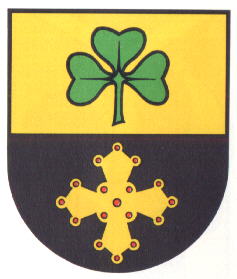Woltwiesche: Difference between revisions
Jump to navigation
Jump to search
Knorrepoes (talk | contribs) m (Text replace - "|width="15%"|50 px|right |}" to "|width="15%"|50 px|right |}<seo title="Wappen, Gemeindewappen" />") |
Knorrepoes (talk | contribs) m (Text replace - "[[Literature" to "{{media}} [[Literature") |
||
| Line 20: | Line 20: | ||
The clover leaf in the upper part is a canting symbol, the name can be derived from Wald-wiese, of forest-meadow. The leaf refers to the meadow part of the name. The base shows a bronze cross dating from the 9th century, which was excavated near the village. It symbolises the long inhabitation of the area. | The clover leaf in the upper part is a canting symbol, the name can be derived from Wald-wiese, of forest-meadow. The leaf refers to the meadow part of the name. The base shows a bronze cross dating from the 9th century, which was excavated near the village. It symbolises the long inhabitation of the area. | ||
{{media}} | |||
[[Literature]] : Rabbow, 1977 | [[Literature]] : Rabbow, 1977 | ||
Revision as of 09:13, 9 July 2014
| Heraldry of the World Civic heraldry of Germany - Deutsche Wappen (Gemeindewappen/Kreiswappen) |
WOLTWIESCHE
State : Niedersachsen
District (Kreis) : Peine
Incorporated into : 1972 Lengede
Official blazon
Origin/meaning
The arms were officially granted on December 20, 1952.
The clover leaf in the upper part is a canting symbol, the name can be derived from Wald-wiese, of forest-meadow. The leaf refers to the meadow part of the name. The base shows a bronze cross dating from the 9th century, which was excavated near the village. It symbolises the long inhabitation of the area.
Contact and Support
Partners:
Your logo here ?
Contact us
© since 1995, Heraldry of the World, Ralf Hartemink 
Index of the site
Literature : Rabbow, 1977











